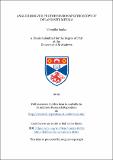Files in this item
Angle resolved photoemission spectroscopy of delafossite metals
Item metadata
| dc.contributor.advisor | King, Phil | |
| dc.contributor.advisor | Mackenzie, Andrew | |
| dc.contributor.author | Sunko, Veronika | |
| dc.coverage.spatial | iv, 242 p. | en_US |
| dc.date.accessioned | 2019-09-30T14:32:03Z | |
| dc.date.available | 2019-09-30T14:32:03Z | |
| dc.date.issued | 2019-06-24 | |
| dc.identifier.uri | https://hdl.handle.net/10023/18582 | |
| dc.description.abstract | This thesis describes the results of angle resolved photoemission spectroscopy (ARPES) experiments on delafossite oxide metals, and theoretical work explaining the observations. The main results of the thesis are reported in three chapters, each of which is dedicated to a different physical observation, as I describe below. The delafossite metals exhibit extraordinarily high conductivity, motivating a study of bulk electronic structure. I report measurements of the bulk electronic structure of the non-magnetic delafossites PdCoO₂ and PtCoO₂. In each, a single fast band crosses the Fermi level, resulting in a highly two-dimensional Fermi surface of nearly hexagonal cross-section. The detailed differences between the materials are described, and so are the possible many-body renormalisations. Extension of the measurements to the electronic structure of the antiferromagnetic delafossite metal PdCrO₂ reveals a signal which I realised cannot be explained in terms of standard pictures of electron behaviour in a periodic potential. Using a combination of experiment and theory, partly in collaboration with external groups, we were able to identify its origin as the Kondo-like coupling of itinerant Pd - and localised Cr - electrons. In doing so we are able to show that that ARPES can be sensitive to spin-spin correlations. Furthermore, I report measurements and analysis of the surface states arising from the transition metal terminated surfaces of PtCoO₂, PdCoO₂ and PdRhO₂. The states support a large Rashba-like spin-splitting, the energy scale of which is comparable to the atomic spin-orbit coupling of the relevant transition metal ion. I show how this arises as a consequence of the large energy scale of inversion symmetry breaking at the surface, and that this is in turn a consequence of the unusual structure of the transition metal oxide layer. | en_US |
| dc.description.sponsorship | "Lastly, I would like to acknowledge financial support from the Engineering and Physical Sciences Research Council via the Scottish Condensed Matter Centre for Doctoral Training under grant no. EP/L015110/1, and from the Max Planck Society." -- Acknowledgements | en |
| dc.language.iso | en | en_US |
| dc.publisher | University of St Andrews | |
| dc.relation | https://doi.org/10.17630/0b976971-8f36-48d1-a662-e13f4629400d | |
| dc.relation | Angle resolved photoemission spectroscopy of delafossite metals (thesis data) Sunko, V., University of St Andrews. DOI: https://doi.org/10.17630/0b976971-8f36-48d1-a662-e13f4629400d | en |
| dc.relation.uri | https://doi.org/10.17630/0b976971-8f36-48d1-a662-e13f4629400d | |
| dc.title | Angle resolved photoemission spectroscopy of delafossite metals | en_US |
| dc.type | Thesis | en_US |
| dc.contributor.sponsor | Engineering and Physical Sciences Research Council (EPSRC) | en_US |
| dc.contributor.sponsor | Scottish Doctoral Training Centre in Condensed Matter Physics (CM-CDT) | en_US |
| dc.contributor.sponsor | Max-Planck-Gesellschaft zur Förderung der Wissenschaften | |
| dc.type.qualificationlevel | Doctoral | en_US |
| dc.type.qualificationname | PhD Doctor of Philosophy | en_US |
| dc.publisher.institution | The University of St Andrews | en_US |
| dc.identifier.doi | https://doi.org/10.17630/10023-18582 |
This item appears in the following Collection(s)
Items in the St Andrews Research Repository are protected by copyright, with all rights reserved, unless otherwise indicated.

